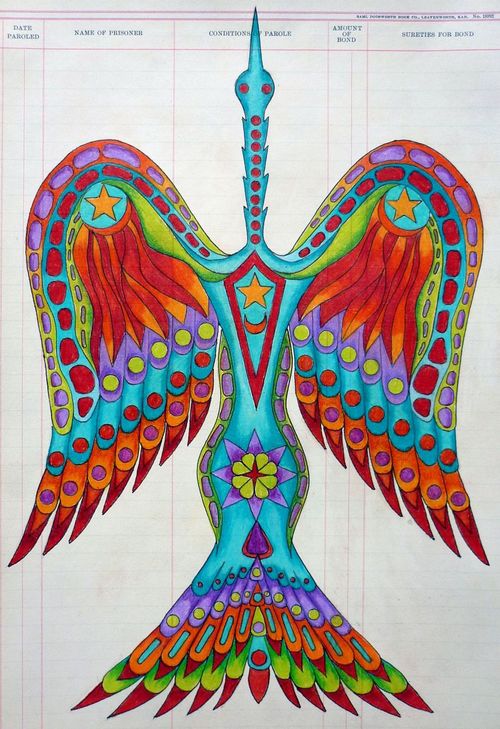
Waterbird #8, Ledger Paper, Mixed Media, Delores Purdy.
Both classical and contemporary ledger art is known for its primary colors and simplicity of line that makes it jump off the page. Dolores Purdy’s consciously unorthodox take on the medium has those bold, complimentary colors and simple lines, but it’s also informed by a lifetime’s worth of pop, psychedelic, and commercial art. Her delicately layered colors and decidedly 20th century patterns (like flame jobs, polka dots, and Peter Max-like stars) are populated by faceless warriors who are both traditional and reminiscent of the featureless figures that inhabit the surrealist works of Magritte and de Chirico.
Purdy not only practices the art form, she also lectures on ledger art, and she is featured in the new book Women and Ledger Art: Four Contemporary Native American Artists by Richard Pearce (University of Arizona Press) which also includes the works of Sharron Ahtone Harjo (Kiowa), Colleen Cutschall (Oglala Lakota), and Linda Haukaas (Sicangu Lakota).
“Ledger art has taken off but 10 years ago, when I started doing it, no one had heard of it,” Purdy said. She is a member of the Standards Committee for Santa Fe Indian Market (SWAIA) and said she was amazed at how much ledger art was sent in this year. “Now everyone has heard of it and a lot of people have jumped on the bandwagon. Unfortunately not all of them know exactly what the beginning, or what the history of ledger art, is all about.”
The art form comes out of the Plains Indians’ tradition of painting on hides, but once the government started eradicating the buffaloes, Native artists turned to new materials they received through contact with European culture, such as fountain pens, commercial paint, pencils, and paper - often in the form of discarded ledger books. One of the major and more ironic evolutions of the form happened at Fort Marion in St. Augustine, Florida in the 1870s; 71 Cheyenne, Kiowa, Comanche, Arapaho, and Caddo warriors and one woman, the supposed leaders of the Red River War, were imprisoned there. The camp was run by Richard Henry Pratt who later founded Carlisle Indian Industrial School, and he was a firm believer in reeducating Native Americans so they could assimilate into white culture (in other words, cultural genocide). In this process, he introduced new art materials to a group of Natives who would become noted artists, and would preserve their traditions and designs and build on them with these materials, including Howling Wolf (Ho-na-nist-to, Cheyenne), David Pendleton Oakerhater (O-kuh-ha-tuh, Cheyenne), Paul Caryl Zotom (Zo-Tom, Kiowa) and many others.
Purdy found her calling while she was researching her Caddo family. One of her relatives was a prisoner at Fort Marion in 1875, and that led her to a book of Fort Marion Ledger Art. “I started flipping through the book and saw some of the art that was coming out of Fort Marion and I couldn’t believe how sophisticated their work really was,” Purdy said. “They could take three colors, black, yellow, and red, and draw an entire huge team with 16 people and 17 horses. I’m a trained water colorist but from that point on I just moved into ledgers because I was enthralled with them, and it’s kind of cool being related to one of those guys.”
She has trouble finding paper because she only uses pre-20th century cotton and linen paper (20th century wood pulp paper disintegrates) and it also has to have something printed on it that will contrast with her art. For example, her piece “Buffalo Hunt 2” is a page of music of the song “Show Yourselves, Men” on which she drew two warriors chasing buffalo.
“It’s like two stories in one,” Purdy said, “not only do you have what was happening in the non-native world, whether or not it was in the store, or in the court, or wherever, but then the native people were putting a whole new look on it. I like to do teepees on old deeds so it has a juxtaposition of different aspects of owning property.”
Purdy also has visual commentaries hidden throughout her work. She pointed out that in her paintings with multiple figures, such as “The Road,” “Caddolac 2,” and “War Hero 2,” either a horse or a rider is looking out of the painting at the viewer. “The horses all have these obnoxious expressions like ‘Gawd! We’re doing this again?’” she laughed.
The absence of faces on her human figures is an invitation for the viewer to put whatever expression he or she wants to on them. “It’s another layer of drawing the audience in to the scene, Purdy said. “They can then decide whether or not they want it to be someone who is very aggressive or maybe someone who’s just going along with the ride."
indiancountrytodaymedianetwork.com
OC
Kin 170: White Magnetic Dog
I unify in order to love
Attracting loyalty
I seal the process of heart
With the magnetic tone of purpose
I am guided by my own power doubled.
Psi bank is to noosphere what brain is to mind.*
*Star Traveler's 13 Moon Almanac of Synchronicity, Galactic Research Institute, Law of Time Press, Ashland, Oregon, 2015-2016.
The Sacred Tzolk'in
Muladhara Chakra (Seli Plasma)





No comments:
Post a Comment